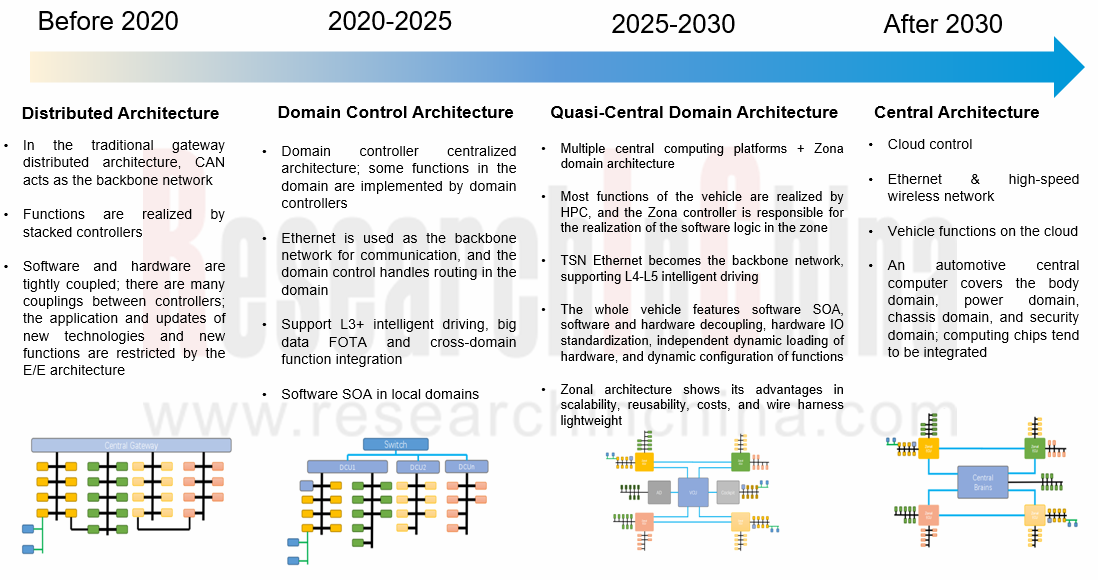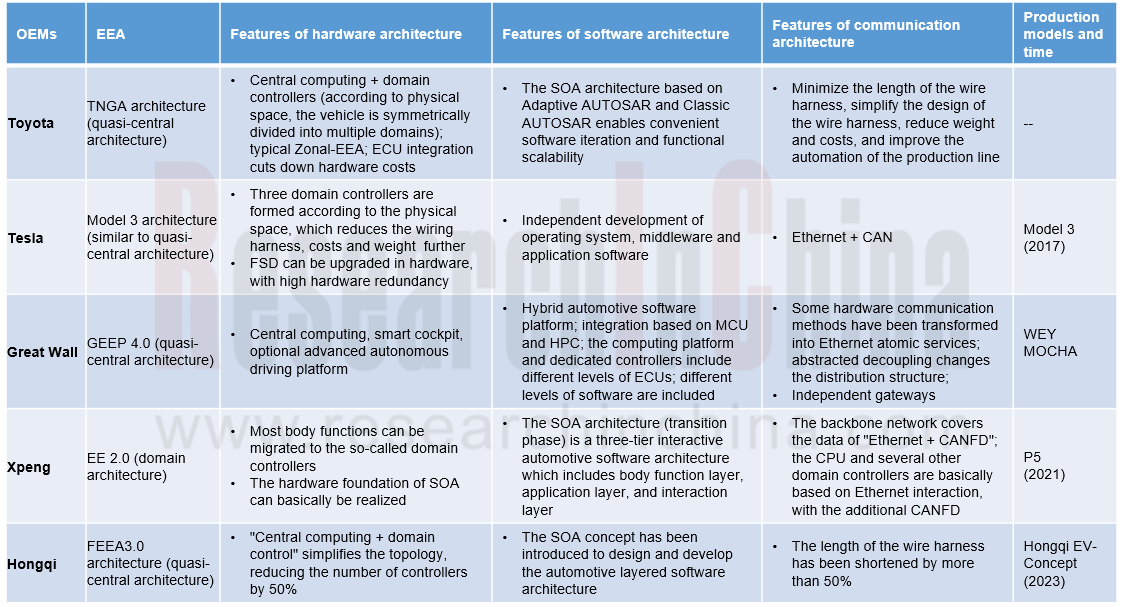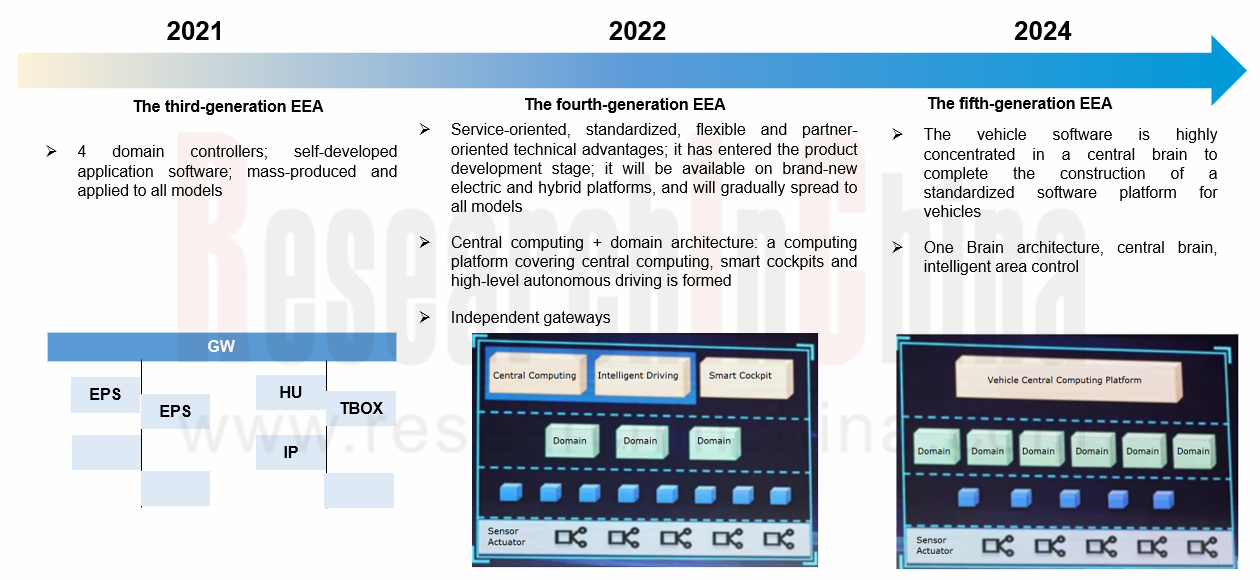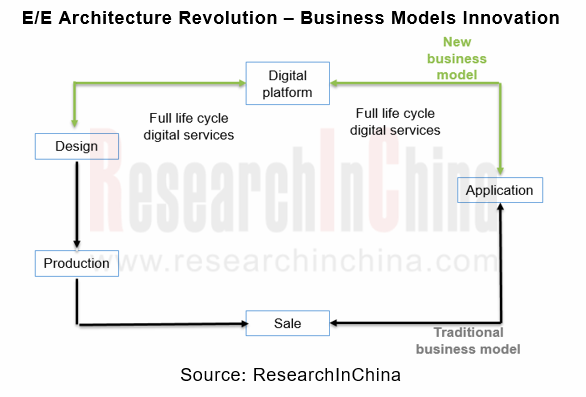Intelligent Vehicle E/E Architecture and Computing Platform Industry Research Report, 2021
E/E Architecture and Computing Platform Industry Research: Three Evolution Stages of Automakers’ E/E Architectures
Domain centralized architectures will gradually evolve to quasi-central and central computing architectures
The evolution of the brand-new automotive E/E architecture, which may take ten years, can be divided into three stages:
(1) Domain centralized architecture stage
At present, automakers mainly stay at the domain centralized architecture stage. For example, Volkswagen's E3 architecture, Great Wall’s GEEP3.0 architecture, BYD's E platform 3.0 architecture, Geely's SEA architecture, Xpeng's EE 2.0 architecture, etc. are all typical domain centralized architectures.
Automotive E/E architectures will inevitably develop towards centralized E/E architectures. From the perspective of mass-produced models, centralized E/E architectures prevail now, with domain control over power, chassis, body, intelligent driving and cockpit. However, it is difficult to fully realize standard domain architectures and central architectures due to technical thresholds, diversified configuration gradients, consumption habits and other factors, so the domain hybrid architecture of "distributed ECUs + domain controllers" will be common in the short term.
At present, Volkswagen, BMW, Geely ZEEKR, Huawei, Visteon, etc. adopt three-domain E/E architecture solutions which mainly include intelligent driving domain, intelligent cockpit domain, and vehicle controller domain.
Volkswagen has upgraded the MQB distributed E/E architecture to the MEB (E3) domain centralized E/E architecture which includes 3 domain controllers: vehicle control (ICAS1), intelligent driving (ICAS2), and intelligent cockpit (ICAS3). Modules such as chassis and airbags that do not have integration capabilities belong to ICAS1. At present, ICAS1 and ICAS3 have been developed and installed on ID.3, ID.4 and other models, while ICAS2 has not been developed yet.
In terms of the software architecture, E3 adopts a service-oriented architecture, using CP and AP service middleware to enable SOA communication; as for the communication architecture, E3's backbone network is Ethernet.
On the CC architecture, Huawei has launched three domain control platforms of intelligent cockpit (CDC), vehicle control (VDC), and intelligent driving (MDC) respectively, and released related open platforms and operating systems, such as the autonomous driving operating system AOS, the intelligent cockpit operating system HarmonyOS and the vehicle control operating system VOS.
In terms of communication architecture, the CC architecture has set up 3-5 VIUs (vehicle interface units). All actuators and sensors are connected to distributed gateways so as to form loops. Once a single loop fails to work, the other three loops maintain operation, hereby effectively improving safety.
(2) Quasi-central computing architecture stage
In the next step, automakers will work hard in the quasi-central architecture of “the central computing platform + regional controllers”. Through SOA, it shares the computing power of different domain controllers like a central computing platform. The GEEP 4.0 architecture to be launched by Great Wall in 2022 and the FEEA3.0 architecture (to be mass-produced in 2023) released by FAW Hongqi in 2021 are quasi-central architectures.
Tesla’s EEA architecture is the most advanced, at least 5 years ahead of that of traditional automakers. The E/E architecture of Model 3 has marked Tesla’s entry into the quasi-central architecture stage consisting of central computing module (CCM), Body Control Module Left (BCMLH) and Body Control Module Right (BCMRH), basically materializing the prototype of a centralized architecture with the self-developed Linux, FOTA of the whole vehicle and communication via the Ethernet backbone network.
Tesla's quasi-central E/E architecture has sparked a harness revolution. The wiring harness of Model S/Model X is as long as 3 kilometers, while Model 3 reduces the wiring harness length to 1.5 kilometers, and Model Y further shortens it to around 1 kilometer. Tesla's plans to make the length as short as 100 meters.
(3) Central computing architecture stage
From the perspective of development trends, the automotive E/E architecture will eventually evolve to the central computing architecture, concentrating the functional logic to a central controller. The OEM Great Wall plans to launch the central computing architecture GEEP 5.0 in 2024, and Changan also intends to complete the development of its central domain architecture in 2025.
Evolution of Automotive E/E Architecture

Source: ENOVATE
In the next 3-5 years, OEMs will focus on R&D and layout of quasi-central architectures
As per the E/E architecture solutions of traditional automakers, most OEMs at home and abroad have transferred from distributed architectures to domain centralized architectures, and they have taken quasi-central architectures as the focus of R&D and layout in the next 3-5 years. Quasi-central and centralized architectures can effectively reduce the number of controllers and wiring harnesses, promote the further decoupling of automotive hardware and software, and drag down the cost further. In order to keep up with the upgrades of automotive technology, OEMs speed up the deployment of quasi-central architectures, introduce SOA architectures and make layout in central computing platforms, etc..
Features of Next-generation E/E Architectures of Some OEMs

Source: ResearchInChina
Great Wall has independently developed the GEEP E/E architecture which has evolved to the third-generation GEEP 3.0 so far. As the domain control architecture, it boasts 4 domain controllers. With integrated software and hardware and self-developed application software, it has been successfully applied to all models. At present, Great Wall is actively developing the fourth- and fifth-generation E/E architectures.
As “the central computing platform + regional controllers” architecture, the fourth-generation E/E architecture of Great Wall comprises three large computing platforms for central computing, intelligent cockpit, and optional advanced autonomous driving respectively. The central computing platform integrates body, gateways, air conditioning, EV, power chassis and ADAS, featuring cross-domain integration. It is scheduled to be launched in 2022. The fifth-generation E/E architecture is to highly concentrate the entire automotive software in a central brain to achieve 100% SOA, and it will be available in 2024.
Evolution of Great Wall’s E/E Architecture

Source: ResearchInChina
The FEEA2.0E/E architecture developed by FAW Hongqi independently is a domain control architecture consisting of a new energy vehicle controller, a L3/L4 autopilot controller, and a central gateway controller. It has been mass-produced for E-HS9. FEEA3.0, a next-generation E/E architecture, was released in April 2021 as a quasi-central architecture of “the central computing platform + regional controllers”, reducing the number of controllers and the total length of the wiring harness by more than 50%, as well as adding. It is planned to be deployed on Hongqi EV-Concept in 2023.
Trends under new E/E architectures
As automotive E/E architectures gradually develop toward central architectures, the centralization of computing power, software services, and peripheralization of sensors and actuators tend to be more obvious; the industrial chain structure has been reshaped, and the business model has undergone significant changes.
(1) The supply chain system is reshaped
Under the traditional distributed E/E architecture, the hardware and algorithms of controllers are provided by Tier 1 suppliers and OEMs coordinate different suppliers, so that the collaboration is extremely inefficient.
Under the new E/E architecture, OEMs enjoy the dominance. Based on their own software and hardware platforms, they directly convey their demand to suppliers, among which Tier 1 suppliers are no longer dominant while Tier 0.5 suppliers emerge to provide algorithms and software for autonomous driving.

(2) The traditional "turnkey" model transfers to the "full stack" development model
OEMs manipulate the development of software platforms (covering functions integrated, suppliers, etc.) to accomplish deeper development. With the development of autonomous driving technology, OEMs are more inclined to carry out "full-stack" development: they gradually master E/E architectures, operating systems, core algorithms, cloud big data, chips and other capabilities, then provide sustainable and iterative product experience and services with a focus on smart scenarios and consumer experience.
(3) Business models are innovated, and the vehicle OTA sees the completed closed loop of business models
In addition, with the evolution of E/E architectures and the rapid development of vehicle OTA, the sales models of automobiles have altered accordingly. Automakers have turned from one-time product providers to “products + full life cycle services” providers. Around smart scenarios and consumer experience, they provide sustainable and iterative product experience and services. Emerging automakers represented by Tesla update software to iterate and upgrade vehicles.
In addition to vehicle sales, OEMs may charge software updates via OTA in the future. For example, the leader Tesla has earned more than USD1.2 billion from software updates.

Intelligent Vehicle E/E Architecture and Computing Platform Industry Research Report 2021 by ResearchInChina mainly studies the following:
 Overview, technology evolution trends, reform trends, market size, etc. of automotive E/E architectures;
Overview, technology evolution trends, reform trends, market size, etc. of automotive E/E architectures;
 Status quo, evolution trends, etc. of E/E architectures of major OEMs (emerging brands, independent brands, foreign brands);
Status quo, evolution trends, etc. of E/E architectures of major OEMs (emerging brands, independent brands, foreign brands);
 Status quo, planning, etc. of E/E architectures of major Tier 1 enterprises;
Status quo, planning, etc. of E/E architectures of major Tier 1 enterprises;
 Status quo of main E/E architectures (including computing architecture, software architecture, communication architecture, power management architecture, etc.);
Status quo of main E/E architectures (including computing architecture, software architecture, communication architecture, power management architecture, etc.);  Solutions of major manufacturers; evolution of new E/E architectures.
Solutions of major manufacturers; evolution of new E/E architectures.
China Automotive Lighting and Ambient Lighting System Research Report, 2025
Automotive Lighting System Research: In 2025H1, Autonomous Driving System (ADS) Marker Lamps Saw an 11-Fold Year-on-Year Growth and the Installation Rate of Automotive LED Lighting Approached 90...
Ecological Domain and Automotive Hardware Expansion Research Report, 2025
ResearchInChina has released the Ecological Domain and Automotive Hardware Expansion Research Report, 2025, which delves into the application of various automotive extended hardware, supplier ecologic...
Automotive Seating Innovation Technology Trend Research Report, 2025
Automotive Seating Research: With Popularization of Comfort Functions, How to Properly "Stack Functions" for Seating?
This report studies the status quo of seating technologies and functions in aspe...
Research Report on Chinese Suppliers’ Overseas Layout of Intelligent Driving, 2025
Research on Overseas Layout of Intelligent Driving: There Are Multiple Challenges in Overseas Layout, and Light-Asset Cooperation with Foreign Suppliers Emerges as the Optimal Solution at Present
20...
High-Voltage Power Supply in New Energy Vehicle (BMS, BDU, Relay, Integrated Battery Box) Research Report, 2025
The high-voltage power supply system is a core component of new energy vehicles. The battery pack serves as the central energy source, with the capacity of power battery affecting the vehicle's range,...
Automotive Radio Frequency System-on-Chip (RF SoC) and Module Research Report, 2025
Automotive RF SoC Research: The Pace of Introducing "Nerve Endings" such as UWB, NTN Satellite Communication, NearLink, and WIFI into Intelligent Vehicles Quickens
RF SoC (Radio Frequency Syst...
Automotive Power Management ICs and Signal Chain Chips Industry Research Report, 2025
Analog chips are used to process continuous analog signals from the natural world, such as light, sound, electricity/magnetism, position/speed/acceleration, and temperature. They are mainly composed o...
Global and China Electronic Rearview Mirror Industry Report, 2025
Based on the installation location, electronic rearview mirrors can be divided into electronic interior rearview mirrors (i.e., streaming media rearview mirrors) and electronic exterior rearview mirro...
Intelligent Cockpit Tier 1 Supplier Research Report, 2025 (Chinese Companies)
Intelligent Cockpit Tier1 Suppliers Research: Emerging AI Cockpit Products Fuel Layout of Full-Scenario Cockpit Ecosystem
This report mainly analyzes the current layout, innovative products, and deve...
Next-generation Central and Zonal Communication Network Topology and Chip Industry Research Report, 2025
The automotive E/E architecture is evolving towards a "central computing + zonal control" architecture, where the central computing platform is responsible for high-computing-power tasks, and zonal co...
Vehicle-road-cloud Integration and C-V2X Industry Research Report, 2025
Vehicle-side C-V2X Application Scenarios: Transition from R16 to R17, Providing a Communication Base for High-level Autonomous Driving, with the C-V2X On-board Explosion Period Approaching
In 2024, t...
Intelligent Cockpit Patent Analysis Report, 2025
Patent Trend: Three Major Directions of Intelligent Cockpits in 2025
This report explores the development trends of cutting-edge intelligent cockpits from the perspective of patents. The research sco...
Smart Car Information Security (Cybersecurity and Data Security) Research Report, 2025
Research on Automotive Information Security: AI Fusion Intelligent Protection and Ecological Collaboration Ensure Cybersecurity and Data Security
At present, what are the security risks faced by inte...
New Energy Vehicle 800-1000V High-Voltage Architecture and Supply Chain Research Report, 2025
Research on 800-1000V Architecture: to be installed in over 7 million vehicles in 2030, marking the arrival of the era of full-domain high voltage and megawatt supercharging.
In 2025, the 800-1000V h...
Foreign Tier 1 ADAS Suppliers Industry Research Report 2025
Research on Overseas Tier 1 ADAS Suppliers: Three Paths for Foreign Enterprises to Transfer to NOA
Foreign Tier 1 ADAS suppliers are obviously lagging behind in the field of NOA.
In 2024, Aptiv (2.6...
VLA Large Model Applications in Automotive and Robotics Research Report, 2025
ResearchInChina releases "VLA Large Model Applications in Automotive and Robotics Research Report, 2025": The report summarizes and analyzes the technical origin, development stages, application cases...
OEMs’ Next-generation In-vehicle Infotainment (IVI) System Trends Report, 2025
ResearchInChina releases the "OEMs’ Next-generation In-vehicle Infotainment (IVI) System Trends Report, 2025", which sorts out iterative development context of mainstream automakers in terms of infota...
Autonomous Driving SoC Research Report, 2025
High-level intelligent driving penetration continues to increase, with large-scale upgrading of intelligent driving SoC in 2025
In 2024, the total sales volume of domestic passenger cars in China was...